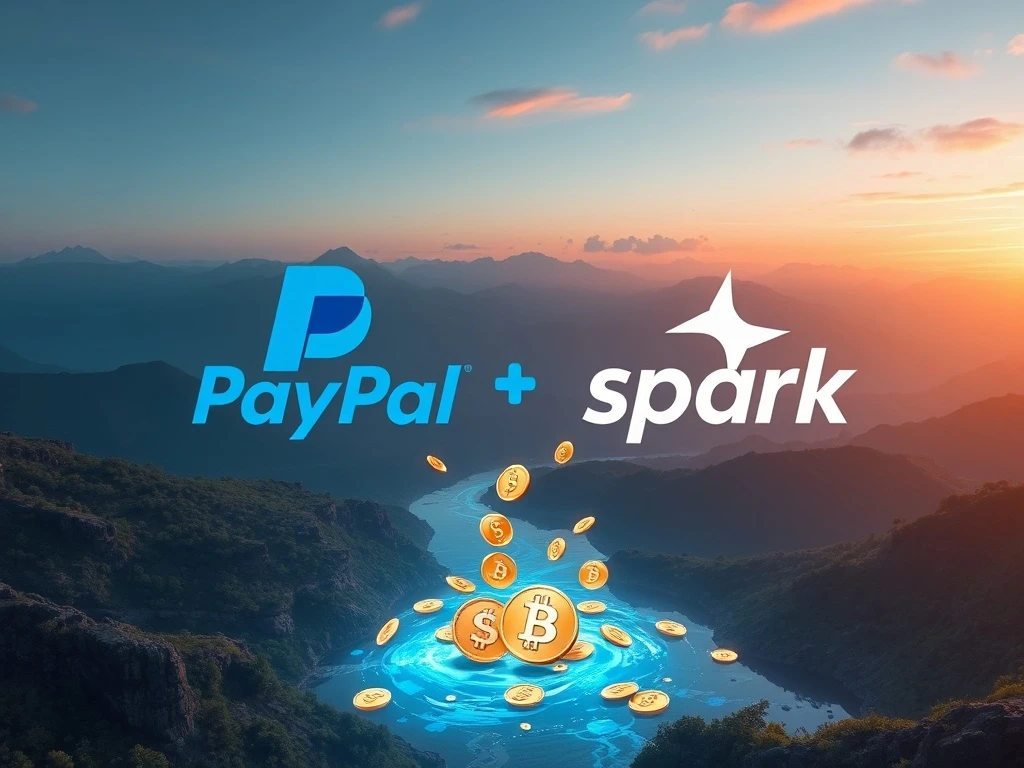PayPal USD Integration: Spark Unlocks Massive DeFi Liquidity

The decentralized finance (DeFi) ecosystem is witnessing a significant evolution. Specifically, a groundbreaking partnership between PayPal and Spark now impacts **PayPal USD (PYUSD)**. This collaboration marks a pivotal moment for **stablecoin lending** and the broader DeFi landscape. Investors and enthusiasts keenly watch this development. It signals a new era for digital assets.
PayPal USD Powers Spark’s DeFi Liquidity
PayPal has strategically partnered with Spark, a leading **Spark DeFi** protocol. This collaboration significantly boosts **PayPal USD (PYUSD)** liquidity. Already, deposits have exceeded $135 million on Spark’s **stablecoin lending** markets. This demonstrates strong market confidence in the integration. PayPal’s stablecoin has garnered over $135 million in deposits since its August listing on SparkLend. SparkLend, a dedicated **stablecoin lending** market, made this announcement in a Thursday statement. Furthermore, SparkLend originated from the MakerDAO ecosystem in 2023. It later integrated into Sky, Maker’s successor entity. Crucially, SparkLend operates the Spark Liquidity Layer. This layer boasts over $8 billion in **crypto stablecoin** reserves, providing robust backing for its operations. This robust infrastructure ensures reliable and efficient transactions within the Spark ecosystem.
Spark’s Strategic Role in Stablecoin Lending

Sam MacPherson, co-founder and CEO of Phoenix Labs, elaborated on this choice. Phoenix Labs serves as a core contributor to **Spark DeFi**. He explained that PayPal selected Spark due to its unique position. Spark is “the only at-scale DeFi protocol that can actively deploy capital into other protocols.” Moreover, MacPherson emphasized DeFi’s future role. He stated, “DeFi will be the rails for all finance in the future. Therefore, focusing on that makes a lot of sense as there is massive growth potential.” This vision underscores the significance of **DeFi liquidity** in the evolving financial landscape. **Spark DeFi** operates as a non-custodial lending protocol. Users deposit **crypto stablecoins** into Spark Savings. In return, they receive non-rebasing yield tokens. According to Messari, these tokens hold a fixed balance. However, their value appreciates over time. Sky governance sets the yields, and protocol revenues fund them. Significantly, **PayPal USD (PYUSD)** successfully passed SparkLend’s rigorous risk assessments. Consequently, it gained official listing on the platform. This move highlights Spark’s commitment to secure and reliable **stablecoin lending** services.
The Surging Crypto Stablecoin Market
The **crypto stablecoin** market is experiencing a significant surge. Its capitalization now approaches $300 billion. This impressive growth follows key regulatory developments. Europe’s Markets in Crypto-Assets Regulation (MiCA) takes effect in January. Additionally, the US passed stablecoin regulation with the Genius Act in July. DeFiLlama data confirms this trend. The market cap has risen over $90 billion since the year began. Clearly, regulatory clarity fuels this expansion. This increasing market size reflects growing confidence in digital assets. It also indicates broader adoption across various financial sectors. The demand for stable, regulated digital currencies continues to climb.
Driving Institutional Adoption and Stablecoin 2.0

Overall **crypto stablecoin** growth parallels increasing demand for yield-bearing stablecoins. For instance, Ethena’s USDe and Sky’s USDS show strong momentum. USDe’s supply grew 70%, and USDS expanded 23% since July 18. That date marked the signing of the Genius Act into law. Furthermore, Coinbase relaunched its Stablecoin Bootstrap Fund in August. This fund aims to inject **DeFi liquidity** for USDC across various DeFi platforms, including Aave and Morpho. However, Coinbase did not disclose the fund’s exact size. A September Binance Research report highlighted a crucial insight. As stablecoin adoption quickens, “DeFi lending protocols are increasingly positioned to facilitate institutional participation.” Indeed, **DeFi lending** markets expanded over 70% year-to-date by September. Institutional demand remains a primary catalyst. This shift towards yield-generating stablecoins represents “stablecoin 2.0.”

“First-generation” tokens, like Tether’s USDt (USDT), primarily digitized the US dollar on-chain. Conversely, a “second generation” of **crypto stablecoins** seeks new utility. They generate yield alongside providing liquidity. This evolution signifies a maturing market. The integration of **PayPal USD** into **Spark DeFi** clearly exemplifies this trend. It promises a dynamic future for **stablecoin lending** and the broader DeFi ecosystem. This progressive movement indicates a shift towards more sophisticated and value-driven digital financial instruments. Consequently, the entire crypto market benefits from these innovations.









